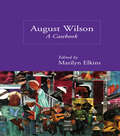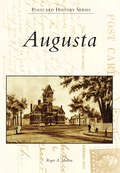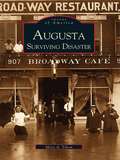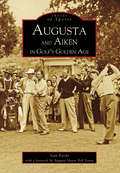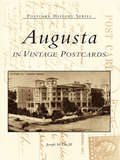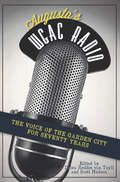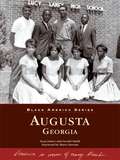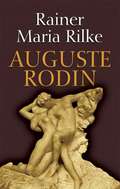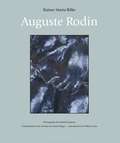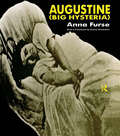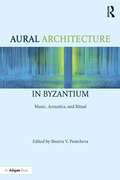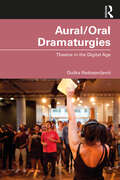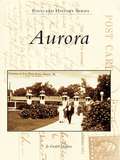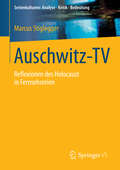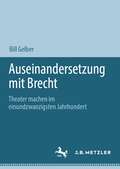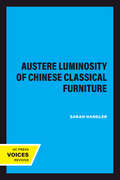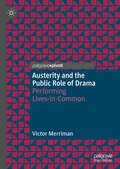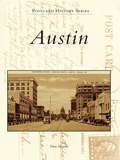- Table View
- List View
August Wilson: A Casebook (Casebooks on Modern Dramatists #Vol. 15)
by Marilyn ElkinsFirst Published in 2000. Routledge is an imprint of Taylor & Francis, an informa company.
Augusta (Postcard History Series)
by Roger A. MadoreBuilt in 1754 on the eastern bank of the Kennebec River, Fort Western became one of the first permanent settlements in what would eventually become Augusta and, in 1827, the capital of Maine. Through innovations in publishing by Gannett & Morse and Vickery & Hill, textiles by the Edwards Manufacturing Company, and lumber production along the Kennebec, Augusta thrived and prospered. Water Street flourished into the business and cultural center of the city, while Green and Winthrop Streets became some of the area's most opulent residential neighborhoods. A trolley system and the Maine Central Railroad station tied Augusta to surrounding communities and allowed visitors to come from far and wide and spend many a night at the famed Augusta House.
Augusta Surviving Disaster: Surviving Disaster (Images of America)
by Misty A. TilsonAugusta: Surviving Disaster allows readers to glimpse the changes that mother nature and human error have wrought on the landscape and design of the "Garden City." These disasters did not only alter the city's landscape; many were the impetus for change in Augusta. The ravaging floods led to the construction of the levee along the Savannah River in 1919, to prevent flooding, and spurred the creation of the Clark Hill Dam and Reservoir. Within this volume, readers will get a glimpse of the damagecaused by the floodwaters of the Savannah River and the Augusta Canal. The remains of St. Paul's Episcopal Church, as well as other homes and businesses, after the Great Fire of 1916 are captured. Historic photographs reveal the damaged remains of the Lower Market after the 1878 tornado. Culled from the extensive collection of the Augusta Museum of History and the personal collection ofJoseph M. Lee III, these images provide testimony to the resiliency of the human spirit and the courage to move forward and rebuild. The citizens of Augusta have a long history of uniting for the common good, and this volume is a tribute to those who overcameobstacles to create the thriving community that exists today.
Augusta and Aiken in Golf's Golden Age (Images of Sports)
by Stan Byrdy Augusta Mayor YoungThe game of golf got its start in the Southeastern United States in 1892 on four holes with sand greens at Palmetto Golf Club in Aiken, South Carolina. Within five years, Palmetto had expanded to eighteen holes and the first nine-hole course in neighboring Augusta, Georgia was designed at the Hotel Bon Air. For half a century, the Augusta-Aiken area flourished as the winter destination of choice for the rich, famous, and powerful in America. Presidents Taft, Harding, and Eisenhower vacationed here. Baseball great Ty Cobb bought a home in Augusta's quaint Summerville neighborhood. It was here that Bobby Jones began the improbable journey towards a Grand Slam, then built his dream golf course. By the turn of the century, winter tourism and grand resort hotels in the Augusta-Aiken area were well established. A favorable winter climate and easy rail access drew vacationers to Highland Park Hotel (1866), Willcox Hotel (1898), and Park in the Pines (1900) in Aiken; Hotel Bon Air (1890) and Partridge Inn (1913) in Augusta; and Hampton Terrace Hotel and Golf Club (1903) in North Augusta. Resorts in Florida and the growth of the air travel industry later coupled to mark the area's decline in winter tourism, but not before Augusta-Aiken's place in golf history was secure. In this unique volume, vintage images and accompanying text recall the unfo rgettable legends, the meticulously maintained courses, and all of the grandeur associated with the game.
Augusta and Summerville
by Joseph M. Lee IIIAugusta and Summerville showcases rare nineteenth-century stereoviews and photographs from the extensive collection of Joseph M. Lee III and the Augusta Museum of History, spanning a 41-year period from 1859 to 1900. The engaging images within these pages were captured on film by some of Augusta's earliest photographers, including J.W. Perkins, JohnUsher Jr., J.A. Palmer, and H.C. Hall, among others. Most of the images have never been published and provide an unusually valuable source of information about Augusta and its environs. Known the world round for its pristine landscapes and "Garden City" charm, Augusta has always been a photographer's dream. Lush, verdant scenes recall a city yet unmarked by the scars of expansion, still enjoying the tranquility of life in the Old South. Views of early businesses and homes on Broad and Greene Streets, the flood of 1888, local monuments, historic churches and cemeteries, pioneering schools, the early cotton crop, and area waterwaysall contribute to this visual journey. The reader will delight in scenes of yesteryear, diving deep into the annals of one of Georgia's most beloved cities.
Augusta in Vintage Postcards (Postcard History Series)
by Joseph M. Lee IIIIn the early 1900s, America was swept up in the postcard craze. All over the country, people seized on these charming snapshots of life as a means of keeping in touch with friends and family, as well as seeing strange and exciting parts of the world.
Augusta's WGAC Radio: The Voice of the Garden City for Seventy Years
by Debra Reddin van Tuyll Scott HudsonWGAC is the No. 1-rated radio station in Augusta. It has weathered the transition in American radio from local stations with local programming to corporately owned stations that feature syndicated programming, and it has been able to do so without giving up its local character. As a news-talk radio station today, WGAC is the first place most Augustans go to find out what is happening nationally and locally, and its morning drive-time and afternoon drive-time show hosts and news personnel are some of the most beloved and respected media figures in Augusta. This book will trace the history of this community landmark from its infancy to its status today as a community institution. It will highlight the people who have created the programming for which WGAC is known and also the people like James Brown who have used the station to launch important careers. The book will also discuss Fuqua's broadcasting technology innovations such as advances in acoustics engineering and early television technology. The history will also cover the station's decades-long support of the Master's Golf Tournament, which has led to it becoming the official radio station of the Master's.
Augusta, Georgia (Black America Series)
by Sean Joiner Marva Stewart Gerald SmithFilled with remarkable vintage photographs, Black America: Augusta, Georgia captures the essence of the African-American heritage in this historic Southern community. The Garden City has produced a wide variety of intellectual and political pioneers, including a handful of educators who were instrumental in the pivotal Brown versus Board of Education case. Within the pages of this volume, their stories unfold.
Auguste Rodin (Dover Fine Art, History of Art)
by Rainer Maria RilkeDuring the early 1900s, the great German poet lived and worked in Paris with Auguste Rodin. In a work as revealing of its author as it is of his famous subject, Rainer Maria Rilke examines Rodin's life and work, and explains the often elusive connection between the creative forces that drive timeless literature and great art.Rilke served for several years as Rodin's secretary — living in the sculptor's workshops, watching the shaping of his creations, and discussing his views and ideas. Written in 1903 and 1907, these essays about the master's work and development as an artist mark Rilke's entry into the world of letters. Rodin himself paid the poet the ultimate tribute, declaring these meditations the supreme interpretation of his work. This excellent translation, complemented by 33 illustrations, will fascinate students of literature, philosophy, and art history.
Auguste Rodin (Lives Of The Artists Ser.)
by Rainer Maria Rilke William H. Gass Michael Eastman Daniel SlagerSculptor Auguste Rodin was fortunate to have his secretary Rainer Maria Rilke, one of the most sensitive poets of our time. These two pieces discussing Rodin¢s work and development as an artist are as revealing of Rilke as they are of his subject. Written in 1902 and 1907, these essays mark the entry of the poet into the world of letters. Rilke¢s description of Rodin reveals the profound psychic connection between the two great artists, both masters of giving visible life to the invisible. Michael Eastman¢ evocative photographs of Rodin¢s sculptures shed light on both Rodin¢s art and Rilke¢s thoughts and catapult them into the 21st century.
Augustine (Contemporary Theatre Studies #Vol. 20)
by Anna FurseFirst Published in 1997. Routledge is an imprint of Taylor & Francis, an informa company.
Augusto Boal (Routledge Performance Practitioners)
by Frances BabbageThis newly-updated volume looks at the scope of Augusto Boal's career from his early work as a playwright and director in Sao Paulo in the 1950s, to the development of his ground-breaking manifesto in the 1970s for a 'Theatre of the Oppressed'. Offering fascinating reading for anyone interested in the role that theatre can play in stimulating social and personal change, this useful study includes: a biographical and historical overview of Boal's career as theatre practitioner and director an in-depth analysis of Boal's classic text on radical theatre an exploration of training and production techniques practical guidance to Boal's workshop methods This is an essential introduction to the work of a practitioner who has had a tremendous impact on contemporary theatre. As a first step towards critical understanding, and as an initial exploration before going on to further, primary research, Routledge Performance Practitioners are unbeatable value for today’s student.
Aural Architecture in Byzantium: Music, Acoustics, and Ritual
by Bissera V. PentchevaEmerging from the challenge to reconstruct sonic and spatial experiences of the deep past, this multidisciplinary collection of ten essays explores the intersection of liturgy, acoustics, and art in the churches of Constantinople, Jerusalem, Rome and Armenia, and reflects on the role digital technology can play in re-creating aspects of the sensually rich performance of the divine word. Engaging the material fabric of the buildings in relationship to the liturgical ritual, the book studies the structure of the rite, revealing the important role chant plays in it, and confronts both the acoustics of the physical spaces and the hermeneutic system of reception of the religious services. By then drawing on audio software modelling tools in order to reproduce some of the visual and aural aspects of these multi-sensory public rituals, it inaugurates a synthetic approach to the study of the premodern sacred space, which bridges humanities with exact sciences. The result is a rich contribution to the growing discipline of sound studies and an innovative convergence of the medieval and the digital.
Aural/Oral Dramaturgies: Theatre in the Digital Age
by Duška RadosavljevićAural/Oral Dramaturgies: Theatre in the Digital Age focuses on the ‘aural turn’ in contemporary theatre-making, examining a number of seemingly disparate trends that foreground speech and sound -- ‘post-verbatim’ theatre, 'amplified storytelling' (works using microphones and headphones), and ‘gig theatre’ that incorporates live music performance. Its main argument is that the dramaturgical underpinnings of these works contribute to an understanding of theatre as an extra-literary activity, greater than the centrality of the script that traditionally dominated many historical discussions. This quality is usually expressed in terms of the corporeality in dance and physical theatre, but the aural/oral turn gives an alternative viewpoint on the interplay between text and performance. The book's case studies draw on the ways in which a range of theatre companies engage with the dramaturgy of speech and sound in their work. It is further accompanied by a specially curated collection of digital resources, including interviews, conversations, and presentations from artists and academics. This is a key text for scholars, students, and practitioners of contemporary performance, and anyone working with dramaturgies of orality and aurality in today’s performance environment.
Aurora
by Jo Fredell HigginsCovered wagons brought a wave of migration to northern Illinois in the mid-1830s. On April 1, 1834, the first permanent white settlers, Joseph McCarthy and two assistants, paddled up the Fox River. The vicinity was known as Waubonsie's Village at that time. They built a log cabin, a dam across the Fox, and eventually a sawmill. The village had about 400 Native Americans who bartered fish for bread and tobacco. For almost 175 years now, growth has been steady and sure, and the city of Aurora is the second-largest metropolitan area in Illinois. Aurora is home to honorable civic institutions, excellent education, and a multicultural and energetic population.
Aurora (Images of America)
by Marcelle R. Wilson Richard FetzerLocated in northeastern Ohio, Aurora began as part of the Connecticut Western Reserve and drew many of its first settlers from New England. The city was founded in 1799, with its residents making their living from hunting, farming, and milling. As settlers cleared the land, planted their crops, and raised their animals, they retained their New England heritage, reflected in the many "century homes" found in the town. The area remained largely rural until the mid-20th century, with dairy farmers shipping cheese all over the country and to Europe from 1850 to 1910. Aurora has served as a bedroom community from the 1900s to the 1960s, and Geauga Lake has been a vacation destination since the 1860s. Currently Aurora retains much of its rural charm with Audubon lands, nature reserves, and many lakes and wetlands.
Auschwitz and After: Race, Culture, and "the Jewish Question" in France
by Lawrence D. KritzmanBeginning with Marcel Ophus's documentary The Sorrow and the Pity (1970) there has been an attempt to question the idea of a totally unified, courageous and resistant wartime France. Even more startling have been the increasingly shocking revelations that the politics of collaboration were a mere extension of a deep-seated French anti-semitic tradition. In the shadow of these developments French writers and philosophers today are reflecting on the meaning of Jewish identity in the contemporary world. Auschwitz and After analyses for the first time how the memory of Auschwitz and the collaboration continue to haunt the French. These critical evaluations are accompianed by provocative essays on the "jewish Question" and the politics of race as they have been studied by writers, historians, philosophers and film makers in postwar France.
Auschwitz-TV: Reflexionen des Holocaust in Fernsehserien (Serienkulturen: Analyse – Kritik – Bedeutung)
by Marcus StigleggerDie Miniserie Holocaust, deren Ausstrahlung 1978 in den USA ca. 100 Millionen Zuschauer verfolgten, erreichte in West-Deutschland ein Jahr später etwa ein Publikum von 16 Millionen. Der Band leitet die Entstehung von Marvin J. Chomskys Holocaust aus der Tradition der TV-Familiensagas (z. B. Roots) her und untersucht nah am Material, welches Bild der historischen Ereignisse diese Fernsehserie und spätere Produktionen inszenieren. Zudem wird die Auswirkung der Serie bis heute verfolgt und veranschaulicht.
Auseinandersetzung mit Brecht: Theater machen im einundzwanzigsten Jahrhundert
by Bill GelberDieses Buch ist ein Plädoyer für Bertolt Brechts anhaltende Bedeutung in einer Zeit, in der die Ereignisse des 21. Jahrhunderts nach einer studierten Art und Weise schreien, Theater für den sozialen Wandel zu produzieren. Hier wird ein einzigartiger Schritt-für-Schritt-Prozess für die Umsetzung von Brechts Arbeitsweisen auf der Bühne vorgestellt, wobei die 2015 an der Texas Tech University entstandene Produktion von Brechts "Mutter Courage und ihre Kinder" als Modell für die Erkundung dient. Besondere Brecht-Konzepte - das Epos, die Verfremdung, die Fabel, der Gestus, die Historisierung, die Literarisierung, das "Nicht...aber", das Arrangement und die Trennung der Elemente - werden erläutert und auf Szenen und Stücke angewendet. Brechts komplizierte Beziehung zu Konstantin Stanislawski wird auch in Bezug auf ihre unterschiedlichen Ansichten über das Schauspiel erforscht. Für Theaterpraktiker und -pädagogen ist dieser Band eine Aufzeichnung des pädagogischen Engagements, eine empirische Studie von Brechts Werk in der Aufführung an einer höheren Bildungseinrichtung mit Studenten und Absolventen.
Austere Luminosity of Chinese Classical Furniture
by Sarah HandlerAustere Luminosity will be the book on Chinese classical furniture. A sumptuous coffee table book with impeccable scholarship, Sarah Handler's expertise will serve as the primary resource for scholars and collectors of Chinese classical furniture for years.
Austere Luminosity of Chinese Classical Furniture
by Sarah HandlerChinese classical furniture is esteemed throughout the world for its beauty, functionalism, and influence on contemporary design aesthetics. Sarah Handler's stunningly illustrated volume traces Chinese hardwood furniture from its earliest origins in the Shang dynasty (c. 1500 to c. 1050 B.C.) to the present. She offers a fascinating and poetic view of Chinese furniture as functional sculpture, a fine art alongside the other Chinese arts of calligraphy, architecture, painting, and literature. Handler, a widely respected scholar of Chinese furniture, uses her knowledge of Chinese social, political, and economic history to provide a backdrop for understanding the many nuances of this art form. Drawing on literary and visual evidence from excavated materials, written texts, paintings, prints, and engravings, she discusses how people lived, their notions of hierarchy, and their perceptions of space. Her descriptions of historical developments, such as the shift from mats to chairs, evoke the psychological and sociological ramifications. The invention of a distinctive way to support and contain people and things within the household is one of China's singular contributions, says Handler. With more than three hundred exquisite illustrations, many in color, Handler's comprehensive study reveals "the magical totality of Chinese classical furniture, from its rich surfaces and shrewd proportions down to the austere soul of art that resides in the hardwood interiors." Austere Luminosity recognizes Chinese classical furniture as one of China's premier arts, unique in the furniture traditions of the world.
Austerity and the Public Role of Drama: Performing Lives-in-Common
by Victor MerrimanThis book asks what, if any, public role drama might play under Project Austerity – an intensification phase of contemporary liberal political economy. It investigates the erosion of public life in liberal democracies, and critiques the attention economy of deficit culture, by which austerity erodes life-in-common in favour of narcissistic performances of life-in-public. It argues for a social order committed to human flourishing and deliberative democracy, as a counterweight to the political economy of austerity. It demonstrates, using examples from England, Ireland, Italy, and the USA, that drama and the academy pursue shared humane concerns; the one, a critical art form, the other, a social enabler of critical thought and progressive ideas. A need for dialogue with emergent forms of collective consciousness, new democratic practices and institutions, shapes a manifesto for critical performance, which invites universities and cultural workers to join other social actors in imagining and enabling ethical lives-in-common.
Austin
by Don MartinAs the capital of Texas, Austin has a long and colorful history. The first residents were nomadic Native Americans who camped here as long ago as 9000 BC because of the area's beauty, the clear Colorado River, and the wildlife. These are the very same things that attract people to Austin today. Originally called Waterloo, Austin has grown from a tiny town on the edge of the western frontier in 1839 into the capital city it is today. The University of Texas lent prestige, the state government erected buildings, the railroads came to town, and Congress Avenue--the "main street" of Texas--filled with thriving businesses.
Austin Murder & Mayhem (Murder And Mayhem Ser.)
by Richard ZeladeAustin&’s past is as weird as its present—including murderous neighbors, deadly political antics, and a serial killer suspected to be Jack the Ripper. Beneath Austin&’s shiny veneer lies a dark past, filled with murder, lechery and deceit. Legislators, lawmen and lawyers killed, robbed and lied just as well and just as often as the drifters and grifters preying on newcomers. The nation&’s first known serial killer made his debut in Austin in the form of the Servant Girl Annihilator, who is still rumored to be Jack the Ripper. After the Willis brothers murdered their neighbors over rumored buried gold, a lynch mob hanged the boys from live oaks on present-day Sixth Street. Freshman representative Louis Franke died after he was robbed and beaten on the steps of the statehouse. Author Richard Zelade delivers a fascinating look at the seedier side of Austin history. Includes photos!
Austin Osman Spare, revised edition: The Life and Legend of London's Lost Artist
by Phil BakerA revised edition of Phil Baker&’s critically lauded biography of artist and occultist, Austin Osman Spare.London has harbored many curious characters, but few more curious than the artist and visionary Austin Osman Spare (1886–1956). A controversial enfant terrible of the Edwardian art world, the young Spare was hailed as a genius and a new Aubrey Beardsley, while George Bernard Shaw reportedly said &“Spare&’s medicine is too strong for the average man.&” But Spare was never made for worldly success and he went underground, falling out of the gallery system to live in poverty and obscurity south of the river. Absorbed in occultism and sorcery, voyaging into inner dimensions, and surrounding himself with cats and familiar spirits, he continued to produce extraordinary art while developing a magical philosophy of pleasure, obsession, and the subjective nature of reality. Today Spare is both forgotten and famous, a cult figure whose modest life has been much mythologized since his death. This groundbreaking biographical study offers wide-ranging insights into Spare&’s art, mind and world, reconnecting him with the art history that ignored him and exploring his parallel London; a bygone place of pub pianists, wealthy alchemists, and monstrous owls. This richly readable and illuminating biography takes us deep into the strange inner world that this most enigmatic of artists inhabited, shedding new light while allowing just a few shadowy corners to flourish unspoiled. Revised, updated, and with a new afterword by the author, this is the definitive edition of Phil Baker&’s critically lauded Austin Osman Spare: The Life and Legend of London&’s Lost Artist.
